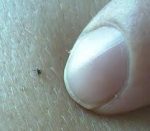
Children & Tick-Borne Disease
Children & Tick-Borne Disease
Children are at risk of tick exposures both within Colorado and when traveling out of state, or country. Children can be exposed through play, sports, camps, school field trips, contact with pets and other family activities. Ticks that transmit Lyme and increasing numbers of co-infections are as tiny as a poppy seed and may be easily missed.
Encouraging patients, especially parents, to practice prevention and conduct ticks checks for their children is a critical part of preventative health care.
Pregnancy
Some diseases, including Lyme, Bartonella, Babesia, Tick-Borne Relapsing Fever, and others may be transmitted congenitally from mother to child during pregnancy.
In a recent case report, Tick-Borne Relapsing Fever (TBRF) in a pregnant host was complicated by Jarisch-Herxheimer reaction requiring critical care.
Women are encouraged to seek medical consult if they contract or suspect infection with tick-borne disease prior to or during pregnancy.
Research Study
The McMaster Midwifery Research Centre is conducting a research project on the perinatal transmission of Lyme disease. This research is being done in order to gather information about Lyme disease in pregnancy and the research priorities of people who have experienced Lyme disease in pregnancy. This project will lay the groundwork for further research on perinatal transmission of Lyme disease. They are seeking women currently or previously pregnant to participate regardless of pregnancy outcome. Link to survey here.
Lyme Disease in Children
According to the CDC, the highest infection rates of Lyme disease occur in children, ages 5 to 15. Of the over 300,000 people infected in the US each year, one in four is a child. Additionally, the CDC acknowledges that Lyme disease may be transmitted from mother to unborn child in utero.
Recognizing signs and symptoms of tick-borne diseases/conditions is crucial in getting timely diagnosis and treatment for your children.
It is important to note that Lyme Disease may present differently in children. Children may present with unique symptoms. And in some pediatric patients, neurological or psychiatric symptoms may be the only sign of an infection. Young children may not recognize or be able to vocalize these signs and symptoms.
In addition to well-known symptoms such as joint pain and fever, children may have a unique presentation of Lyme disease, including:
- Mood Swings
- Vision Problems
- Headaches and Stomachaches
- Hyperactivity/ADHD Symptoms
- Autism-like Behaviors
- Oppositional Behaviors
- Self-Mutilating Behaviors
- Learning Disabilities
- Trouble with Processing Speed and Memory
- Vocal/Motor Tics
- Sudden Onset Anxiety Disorders
- Light and Sound Sensitivity
- Difficulty Focusing
- Obsessive Compulsive Behaviors
- Dark circles under eyes
- Irregular Rashes
- Lethargy
“Some of these symptoms may be very subtle, so it is difficult for [parents and] teachers to realize that they are dealing with a sick child, rather than a child who is daydreaming, or simply trying to avoid his school work.”
—S. Berenbaum, LCSW
Sometimes neurological/cognitive symptoms are the only symptoms that present in a child with a Lyme disease infection. Other times better known symptoms like joint pain, fever, and an Erythema migrans (“Bulls-Eye”) rash are present.
Some children with tick-borne disease have been accused of malingering, or trying to be manipulative. Parents, coaches and teachers should be aware that children who appear to have disingenuous symptoms could be very ill, and that a child’s symptoms and abilities may change on a daily basis.
Pediatric Lyme disease has been misdiagnosed as OCD, or pediatric Bi-polar disorder. It may also cause suicidal thoughts and depression. When a child exhibits sudden changes in behavior with no known cause, the possibility of Lyme and other tick-borne infections should be considered.

This tiny tick may be easily missed. Complete thorough tick checks on your children!
Prevention for Kids
Completing TICK CHECKS on your children after time spent outdoors or contact with pets is so important in preventing disease! Timely and proper removal of ticks reduces the chance of disease transmission.
Protect your children by becoming informed about prevention measures, proper tick removal and signs and symptoms of disease. Ticks that can transmit disease can be as small as a poppy seed and easily missed.






